The olive tree bears fruit in branches formed the previous year, so the cultivation techniques are focused on modulating the harvest in quantity and quality in order to optimize the economic and environmental use of the resources used.
The olive tree is a neighbouring species in which years of high and low or no production alternate. The number of fruits by fruitful branch is the result of the vegetative and reproductive processes that happen throughout a biennial reproductive cycle.
Both shoot growth and fruit development are cyclical phenomena in the olive tree. Both are repeated annually, but while shoot growth is completed within the same year, the processes that lead to fructification require two consecutive seasons.
In the first year, buds are formed in the axils of the leaves of the shoots. Their fate, vegetative or reproductive, is determined by the level of harvesting in progress as this is the main factor responsible for the interannual variation in flowering. In the second year, after the winter rest, the potentially reproductive buds that have covered their needs of cold are differentiated in inflorescences or flowers. During the flowering process, pollination, fertilization and fruit set take place, producing a massive abscission of flowers and developing fruits in the 6-8 weeks after flowering. The fruits that remain united to the branch continue their growth until maturation, except falls promoted by abiotic stresses and by plagues and diseases (Rayo y Cuevas, 2017).
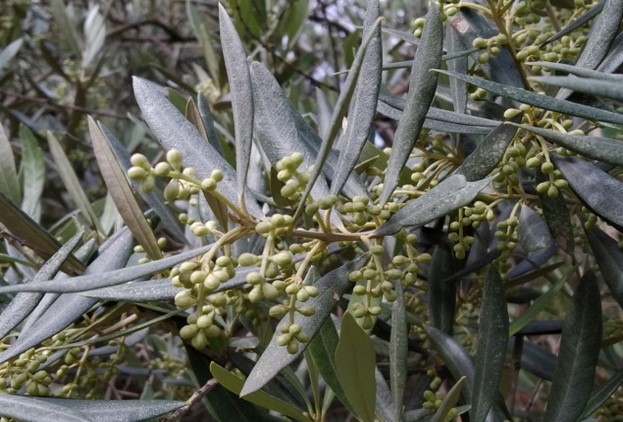
The buds are formed in the axils of the leaves as the shoots grow and form new nodes, remaining at rest until the following spring, when they will begin their sprouting after a period of winter rest where they will accumulate cold (Rubio-Valdés, 2009).
Flower induction and initiation
Floral induction, defined as the internal physiological change in the apical meristem of a bud that determines the floral nature of the bud, is prior to any visible morphological change. The destiny, reproductive or vegetative, of each bud, that is, the acquisition or not of its reproductive potential, must take place before the establishment of the latency, since during this one no cellular division is observed, a necessary condition for the floral induction.
Different studies indicate that floral induction is related to the initial growth of the seed and fruit before the hardening of the stone. The inhibition of floral induction is directly related to the increase of endogenous gibberellins synthesized in the seed endosperm (Stutte and Martin, 1986). This is related to the own neighboring character of the olive tree, so that, the reduction of the flowering is associated to a high production of the previous year, where the abundance of fruits, supposes a high synthesis of giberelins in the seeds.
Most of the buds formed before mid-September on trees in discharge, form inflorescences the following season. Those formed in October either remain dormant or fall off. In contrast, in trees in load, only those few buds formed before mid-July form inflorescences (Piedra et al., 2012). In summary, the presence of fruits during summer and autumn affects the following year’s flowering and suggests the inhibition of floral induction at this time.
The absence of fruit does not necessarily guarantee high flowering the following year. It is only after the start of the dormancy that the floral initiation takes place, which marks the beginning of the reproductive morphological development. The floral initiation is therefore the process experienced by a bud that leads to the irreversible origin of a flower or inflorescence. This process involves internal changes in the buds attributed to a hormonal balance that is affected by external factors.
The olive tree needs winter cold to allow the buds of a variety to overcome dormancy and sprout in conditions favourable to growth. The usual method used to characterise temperature requirements is to evaluate the number of hours with temperatures between 2.5 and 15 °C, with a maximum effect for those around 12.5 °C (Rallo et al., 1994).
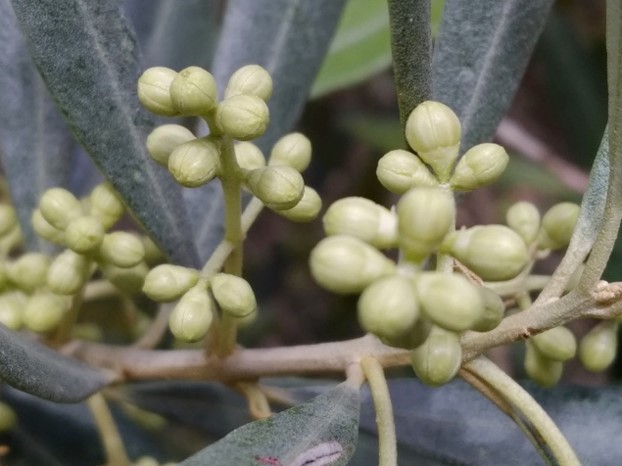
Between 15 and 16º C, they stop accumulating cold and higher temperatures cancel out part of the accumulated cold (De Melo-Abreu et al., 2004). In conditions of nightly cold and mild daytime temperatures, typical of the Mediterranean climate, the cold needs are naturally satisfied during rest (Rubio-Valdés, 2009).
In contrast, in areas where there is not enough cold, flowering is very staggered, with buds observed in very different phenological stages or even all the buds may remain dormant or fall off at budding time in extreme cases, thus not producing flowering.
In this sense, global warming and foreseeable climate change may modify the behaviour of the olive tree in its traditional Mediterranean regions (Rallo and Cuevas, 2017).
Floral differentiation
The flowers of the olive tree are grouped in panicles. The number of flowers per panicle is very variable (12 – 20), with differences between varieties and even between years, for the same variety.
The olive tree is in general an andromonoid plant, with hermaphrodite (perfect) and staminated (imperfect) flowers with rudimentary non-functional pistils.
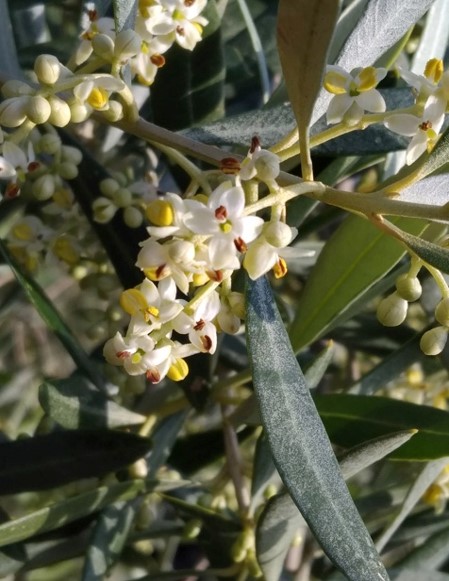
Exceptionally there are androic plants, with staminated flowers only; and trimonoic plants, with hermaphrodite, staminated and pistilized flowers (Fernández-Escobar, 1977).
During the short period of time between the floral initiation and the anthesis in olive tree (from 2.5 to 3 months), certain environmental factors can influence the expression of the sex of the olive flowers (Badr and Hartman, 1971):
- The low temperatures during the period of development of the inflorescence are favorable to the development of the pistil.
- High temperatures cause rapid development of the inflorescences, tending to increase the abortion of the pistil.
- Water shortages or low soil moisture increase ovarian miscarriage.
- The nutritional and health status of the tree also influences the relative proportion of the type of flowers, so that a loss of leaves before anthesis, caused by poor nutrition or by the attack of pathogens, reduces the number of perfect flowers and increases the number of imperfect ones, because of poor flower development.
In general, when conditions are unfavorable, it is the development of the pistil that fails. The reason for pistil abortion
seems to lie in competition for assimilates between flowers and between flowers and actively growing shoots during the pistil development period (Rosati et al., 2011).
Pistilar abortion does not limit the productive capacity of the olive tree in most cases. However, in situations limiting water and nutrients for the crop and strong demand for assimilated (years of high flowering), the processes of development of inflorescences, flowers, ovary and seminal primordiums (eggs), can be conditioned so that they affect the productive capacity of the olive tree. In general, cultivation techniques that favour the growth and development of flowers (early watering and good nutrition) or limit competition between developing flowers (pruning or thinning), promote the productive capacity of flowers that reach flowering (Rallo and Cuevas, 2017).
Pollination
During flowering, pollination takes place, i.e. the transfer of pollen from the anther of the flower to the receptive stigma of the same or another flower. In olive trees, this transport is generally carried out by the wind (anemophilous pollination) which can carry the pollen for miles, although over 95% of the pollen is deposited less than 40 metres from the source (Griggs et al., 1975). In order for the fertilization of the flower to take place, the pollen tube has to follow the path that leads from the stigma to the interior of the embryonic sack, where fertilization will take place giving rise to the future seed and with it, the conversion of the flower into fruit.
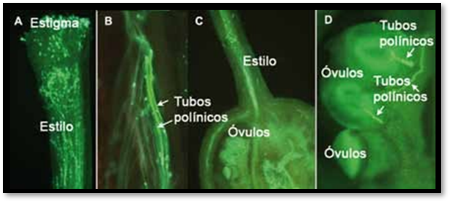 Detail of the pollination of a flower. We see how the pollen grains develop their tubes until they reach the egg. Different levels of detail are observed:
Detail of the pollination of a flower. We see how the pollen grains develop their tubes until they reach the egg. Different levels of detail are observed:
- Detail of the style and the stigma, the growth of the pollen tubes is observed.
- Detail of the style, the pollen tubes are observed.
- Detail of the style and the ovary, the eggs are observed
- Detail of the eggs, with the pollen tubes arriving at their destination.
Fruit set is usually the index used to measure the effectiveness of pollination. But from the floral initiation to the fruit set, a series of processes take place in which certain factors, internal and external, have an influence, whose activation will result in the final fruit set. These are as follows:
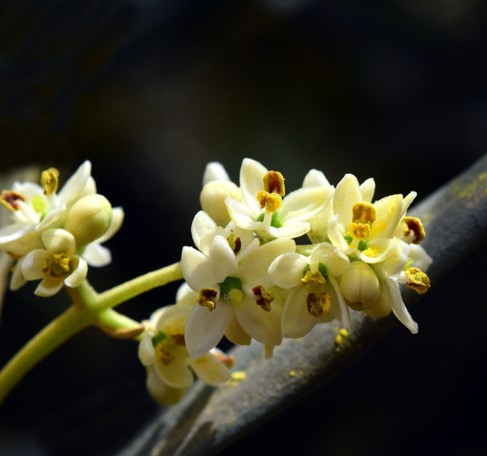
1. Interns:
a) Causes of sterility:
It has a varietal character. Ovarian abortion is determined by the atrophy of the female sexual apparatus (seen above) or by pollen-pisty self-incompatibility, i.e. the pistil of a flower recognizes and biochemically rejects pollen of the same genotype, i.e. pollen of the same variety. At the same time, it selects and allows the growth of the pollen tube from those pollen grains that correspond to other varieties.
b) Influence of variety:
- Pollen production. It occurs when the mature anthers dehiscence, phenomena in which climatic factors directly intervene. But the amount of pollen produced seems to be a varietal character.
- Stigma receptivity period. In general it is greater than in entomophilic pollinated species (Fankel and Galun, 1977). It has been observed that olive stigmas remain receptive until 3-4 days after anthesis (Bradley and Griggs, 1963). Possibly due to the time of flowering of the olive tree (May-June), the period of receptivity is shortened by a premature drying of the stigma.
- Pollen grain germination. This is one of the internal factors that could most affect pollination. The pollen grain forms, together with the seeds, the two dispersing agents of the plants. Both have a mobile phase until the right medium for germination and growth is found. In the case of the pollen grain the germination medium is very specific, a receptive stigma of a compatible variety. The efficiency of transport during the mobile phase can be increased by an abundant production of the donor cultivar.
2. External:
a) Technicians
The design of the plantation in order to improve pollination conditions plays an important role in its efficiency. Among the factors to take into account are:
- The association of varieties, with characteristics such as coincidence of flowering, compatibility, age of entry into production, fruit quality and efficiency in pollen transport.
- Characteristics of the plot, such as surface area, orientation, slope, etc.
b . Climatic
- Temperature: The growth of the pollen tube on a compatible or partially compatible pistil is largely determined by temperature. There is a linear correlation between temperature and pollen tube growth that ceases to be fulfilled at excessively high temperatures, due to premature drying of the stigma. In late flowering areas the effective pollination period may be affected by this.
- Although humidity acts together with temperature, high percentages of pollen germination are associated with winds that increase humidity during spring, while the opposite effect occurs with dry winds (Griggs et al., 1975).
- It is the main agent of pollen transport (anemophilous species). Although bees visit olive flowers, the effect on pollination is slight. However, some beneficial influence may be due to this activity.
c) Nutritionals
The study of the germination conditions of pollen “in vitro” is the method generally used to evaluate its germination capacity, since the “in vivo” study can be masked by the influence of other factors. Over the years, means have been developed to study pollen germination, starting with those based on agar and sucrose in different concentrations, for which low percentages of germination were obtained. Sucrose added to the pollen culture medium is the nutrient generally used in germination studies. The addition of boron in the form of BO3H3 in a culture medium based on aqueous sucrose solutions seems to improve the germination rates.
Fruit set
The tissues of the ovary, which grow regularly until anthesis, now stop growing if pollination has not taken place. In this case the flower falls due to the appearance of an abscission layer. This phenomenon may be intensified by the production of ethylene due to the senescence of the flowers, although this may not be the only cause, since pollination itself triggers a greater release of the gas (Nitsch, 1971).
On the contrary, the growth of the ovary continues in the absence of abscission, as long as the pollen tube germinates in the stigma, without it being necessary for it to reach the embryonic sac. This effect is due to the fact that the germination of the pollen itself on the stigma of the flower triggers a series of hormonal changes responsible for the initial growth of the fruit.
While pollination is the agent capable of causing initial fruit development, fruit growth is controlled by the developing seeds. The influence of seeds on fruit growth is regulated by hormones, mainly auxins, gibberellins and cytokinins, whose levels are detrimental as the seeds mature.
Frost and mist in the early stages of development can be a limiting factor in fruit development. The position of the fruit, associated with nutritional situations or the incidence of some pathogen such as Prays, also affects the development of the fruit. Finally, it is repeatedly verified the differences in fruit set between varieties of the same species, independently of the climate factors, being able to find two types of fruits:
- Normal. Those pollinated with pollen from another compatible variety. They are of normal size and characteristics. They contain one or two seeds.
- Parthenocarpic: Commonly known as “zofairones”, they are fruits developed without fertilization of the egg or the result of an ovarian abortion due to incompatibility of pollen-stigma.
They are small spherical or ovoid fruits, which soon stop growing. They usually fall down before the ripening, although some of them persist in the plant together with the normal fruits.
Recommendation
From the technical department of Cultifort and the R+D of Cultifort, we recommend carrying out pre-flowering treatments with Cultiboro Plus with the aim of improving the viability of the pollen and the germination of the pollen tube. It is a liquid and ecological formulation of Boron complexed with Monoethanolamine which contains reducing sugars, forming a complex to improve their assimilation and transport by the plant. It is also chlorine-free.
The application of Cultiboro Plus is necessary in olive tree to the beginning of the vegetative activity, previous to flowering, as well as to the beginning of the fructification, since the Boron is a multifunctional micronutrient that besides improving the quality of pollen and the growth of the pollen tube, participates in the division and the cellular growth (for that reason its deficiency at foliar level and in fruits, is shown with malformations); together with the Calcium it is essential in the synthesis of cell walls, improving also in a synergic way its mobility in the plant (let’s remember that both nutrients have a reduced mobility); it takes part in the transport of carbohydrates and of Potassium, in the metabolism of Nitrogen and in the formation of proteins; it intervenes in the regulation of the levels of hormones (necessary in the first stages of the development of the fruit); etc.
References
Badr S.A. y Hartman H.T., 1971. Effect of Diurnally Fluctuating vs. Constant temperaturas on flower induction and sex expression in the olive (Olea europaea L.). Physiollogy Plant, 24: 40-45
Bradley M.V. y Griggs W.H., 1963. Morphological evidence of incompatibility in Olea europaea L. Phytomorphology, 13 (2): 141-156.
De Melo-Abreu J.P., Barranco D., Cordeiro A.M., Tous J., Rogado B.M., Villalobos F., 2004. Modelling olive flowering date using chilling for dormancy reléase and termal time. Agricultural and Forest Meteorology, 125(1-2): 117-127
Fernández-Escobar R., 1977. Factors affecting pollination and fruit setting in olive trees (Olea europaea L.).
Frankel R. and Galun E., 1977. Pollination Mechanismes, Reproduction and Plant Breeding. Springer-Verlag.
Griggs W.H., Hartman H.T., Bradley M.V., Iwakiri B.T., Whisler J.E., 1975. Olive pollinitation in California. California Agricultural Experimental Station Bulletin, 869.
NITSCH, J.P. 1.971. Perennation through seeds and other structures. Fruit Development. Plant Physiology. Ed. F.C. Steward. Academic Press. London. 413-479 p
Piedra M.A., González M., Cuevas J., 2012. Olive bud fate depends on node formation date Implications for flower induction timing. Acta Horticulturae, 949: 237-242
Rallo L. and Cuevas J., 2017. The cultivation of the Olive Tree. Fructification and production. Mundi Press Edition. Madrid. 145-186p
Rallo L., Torreño P., Vargas J.A., Alvarado J., 1994. Dormancy and alternate bearing in olive. Acta Horticulturae, 356: 127-136
Rosati A., Caporali S., Paoletti A., Damiani F., 2011. Pistil abortion is related to ovary mass in olive (Olea europaea L.). Scientia Horticulturae, 122(3): 399-403
Rubio-Valdés G., 2009. Growth and dormancy of olive tree reproductive buds (Olea europaea L.).
Stutte G. Y Martin H.C., 1986. Effect of killing the seed on return Bloom of olive. Scietia Horticulturae, 29: 107-113


